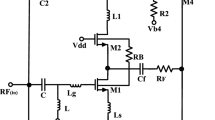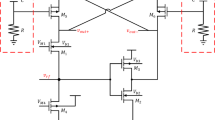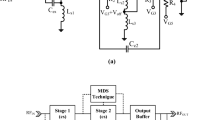Abstract
This paper presents a low-noise amplifier (LNA) with superior linearity for ultra-wideband (UWB) purposes. Linearity is a significant parameter for 5G receivers because the 5G new radio bands overlap with the UWB frequency band. In the proposed design, the Complementary Derivation Superposition (CDS) and the Shunt-Feedback Common Source techniques were combined using a novel circuit topology. The active and passive feedback captured the nonlinear signal, and the auxiliary PMOS transistor helped to realize low noise figure (NF), high gain, and highly linearity. The inductors at the gate and drain, in cooperation with the LC filter, were selected to perform the Input Impedance Matching (IIM) over the entire UWB frequency band. Finally, the novel structure was designed and verified by post-layout simulations using the 65-nm CMOS technology. The results obtained from the Post-Layout simulations in the whole of UWB band (from 3.1 to 10.6 GHz) are as follows: the power gain and NF are 12.4 ± 0.3 dB and 3.6 ± 0.3 dB, respectively. The S11 parameter is better than − 10 dB in the desired band. The circuit consumes 10.56 mW under 1.2 V supply voltage. The maximum and average of third-order Input Intercept Point (IIP3) are 17.93 dBm and 6.22 dBm, respectively. The layout size of the proposed LNA is 0.827 mm2. In addition, a compressive Process-Voltage-Temperature (PVT) analysis is presented, that proves the circuit robustness against process, voltage and temperature variations.


















Similar content being viewed by others
References
Duan, Z., & Liang, J. (2019). Non-contact detection of vital signs using a uwb radar sensor. IEEE Access, 7, 36888–36895. https://doi.org/10.1109/ACCESS.2018.2886825
Rasekh, A., & Bakhtiar, M. S. (2019). Wide-band rf front end for saw-less receivers employing active feedback and far out-of-band blocker rejection circuit. IEEE Journal of Solid-State Circuits, 54(6), 1528–1540. https://doi.org/10.1109/JSSC.2019.2894996
Hedayati, H., Lau, W. F. A., Kim, N., Aparin, V., & Entesari, K. (2015). A 1.8 dB NF blocker-filtering noise-canceling wideband receiver with shared TIA in 40 nm CMOS. IEEE Journal of Solid-State Circuits, 50(5), 1148–1164. https://doi.org/10.1109/JSSC.2015.2403324
Huang, D., Yang, X., Chen, H., Khan, M. I., & Lin, F. (2018). A 0.3–3.5 GHz active-feedback low-noise amplifier with linearization design for wideband receivers. AEU—International Journal of Electronics and Communications, 84, 192–198. https://doi.org/10.1016/j.aeue.2017.12.003
Luo, P., Liu, M., Chen, L., Gao, J., Zhu, Z., & Yang, Y. (2019). A 2.99 dB NF 15.6 dB Gain 3–10GHz Ultra-wideband low-noise amplifier for UWB systems in 65 nm CMOS. Analog Integrated Circuits and Signal Processing, 101(3), 651–657. https://doi.org/10.1007/s10470-019-01547-2
Kumar, M., & Deolia, V. K. (2019). A wideband design analysis of LNA utilizing complimentary common gate stage with mutually coupled common source stage. Analog Integrated Circuits and Signal Processing, 98(3), 575–585. https://doi.org/10.1007/s10470-018-1355-6
Moghadam, P. P., & Abrishamifar, A. (2017). An inductorless wideband LNA with a new noise canceling technique. Turkish Journal of Electrical Engineering and Computer Sciences, 25(2), 1147–1153. https://doi.org/10.3906/elk-1407-104
Eskandari, R., Ebrahimi, A., & Baghtash, H. F. (2020). Low power balanced balun LNA employing double noise-canceling techniques. Analog Integrated Circuits and Signal Processing, 105(3), 305–318. https://doi.org/10.1007/s10470-020-01690-1
Kim, J., Hoyos, S., & Silva-Martinez, J. (2010). Wideband common-gate CMOS LNA employing dual negative feedback with simultaneous noise, gain, and bandwidth optimization. IEEE Transactions on Microwave Theory and Techniques, 58(9), 2340–2351. https://doi.org/10.1109/TMTT.2010.2057790
Kim, B. K., Im, D., Choi, J., & Lee, K. (2014). A highly linear 1 GHz 1.3 dB NF CMOS low-noise amplifier with complementary transconductance linearization. IEEE Journal of Solid-State Circuits, 49(6), 1286–1302. https://doi.org/10.1109/JSSC.2014.2319262
Sahafi, A., Sobhi, J., & Koozehkanani, Z. D. (2016). Linearity improvement of gm-boosted common gate LNA: Analysis to design. Microelectronics Journal, 56, 156–162. https://doi.org/10.1016/j.mejo.2016.08.015
Tarighat, A. P., & Yargholi, M. (2016). A CMOS low noise amplifier with employing noise cancellation and modified derivative superposition technique. Microelectronics Journal, 54, 116–125. https://doi.org/10.1016/j.mejo.2016.05.015
Jafarnejad, R., Jannesari, A., & Sobhi, J. (2017). A linear ultra wide band low noise amplifier using pre-distortion technique. AEU—International Journal of Electronics and Communications, 79, 172–183. https://doi.org/10.1016/j.aeue.2017.05.046
Guo, B., & Li, X. (2013). A 1.6–9.7 GHz CMOS LNA linearized by post distortion technique. IEEE Microwave and Wireless Components Letters, 23(11), 608–610. https://doi.org/10.1109/LMWC.2013.2281426
Yu, H., Chen, Y., Boon, C. C., Mak, P. I., & Martins, R. P. (2020). A 0.096-mm2 1–20-GHz triple-path noise- canceling common-gate common-source LNA with dual complementary pMOS-nMOS configuration. IEEE Transactions on Microwave Theory and Techniques, 68(1), 144–159. https://doi.org/10.1109/TMTT.2019.2949796
Yaghouti, B. D., & Yavandhasani, J. (2021). A high linearity low power low-noise amplifier designed for ultra-wide-band receivers. Analog Integrated Circuits and Signal Processing, 107(1), 109–120. https://doi.org/10.1007/s10470-020-01783-x
Rastegar, H., & Ryu, J. Y. (2015). A broadband Low Noise Amplifier with built-in linearizer in 0.13-μm CMOS process. Microelectronics Journal, 46(8), 698–705. https://doi.org/10.1016/j.mejo.2015.05.006
Dai, R., Zheng, Y., He, J., Kong, W., & Zou, S. (2017). A duplex current-reused CMOS LNA with complementary derivative superposition technique. International Journal of Circuit Theory and Applications, 45(1), 110–119. https://doi.org/10.1002/cta.2235
Hampel, S. K., Schmitz, O., Tiebout, M., & Rolfes, I. (2009). Inductorless 1–10.5 GHz wideband LNA for multistandard applications. In Proceedings of Technical Papers—2009 IEEE Asian Solid-State Circuits Conference, A-SSCC 2009, 269–272. https://doi.org/10.1109/ASSCC.2009.5357261
Chen, M., & Lin, J. (2009). A 0.1–20 GHz low-power self-biased resistive-feedback LNA in 90 nm digital CMOS. IEEE Microwave and Wireless Components Letters, 19(5), 323–325. https://doi.org/10.1109/LMWC.2009.2017608
Bozorg, A., & Staszewski, R. B. (2021). A 02–4-GHz LN(T)A in 28-nm CMOS for 5G exploiting noise reduction and current reuse. IEEE Journal of Solid-State Circuits, 56(2), 404–415. https://doi.org/10.1109/JSSC.2020.3018680
Sahoolizadeh, H., Jannesari, A., & Dousti, M. (2018). Noise suppression in a common-gate UWB LNA with an inductor resonating at the source node. AEU—International Journal of Electronics and Communications, 96, 144–153. https://doi.org/10.1016/j.aeue.2018.09.007
Traversi, G., Manghisoni, M., Re, V., Gaioni, L., & Ratti, L. (2012). Perspectives of 65 nm CMOS technologies for high performance front-end electronics. Proceedings of Science, 2012-Septe. https://doi.org/10.22323/1.167.0026
Post, I., Akbar, M., Curello, G., Gannavaram, S., Hafez, W., Jalan, U., & Jan, C. H. (2006). A 65nm CMOS SOC technology featuring strained silicon transistors for RF applications. Technical Digest—International Electron Devices Meeting, IEDM. https://doi.org/10.1109/IEDM.2006.346816
Chaharmahali, I., Asadi, S., Dorostkar, B., & BosraMalaknezhadAbedini, M. M. M. (2017). A new method modifying single miller feedforward frequency compensation to drive large capacitive loads: Putting an attenuator in the path. Analog Integrated Circuits and Signal Processing, 93(1), 61–70. https://doi.org/10.1007/s10470-017-1026-z
Hsieh, J. Y., & Lin, K. Y. (2020). A 0.6-V low-power variable-gain LNA in 0.18-\mu m CMOS technology. IEEE Transactions on Circuits and Systems II: Express Briefs, 67(1), 23–26. https://doi.org/10.1109/TCSII.2019.2902301
Saberkari, A., Shirmohammadli, V., & Yagoub, M. C. E. (2016). A 3–6 GHz current reused noise canceling low noise amplifier for WLAN and WPAN applications. Wireless Personal Communications, 86(3), 1359–1376. https://doi.org/10.1007/s11277-015-2993-y
Hari Kishore, K., Prakash, S., & Venkataramani, B. (2020). 1.2 V asymmetric-CCC based sub-3 dB NF high IIP3 linearity wideband balun-LNA. AEU—International Journal of Electronics and Communications. https://doi.org/10.1016/j.aeue.2020.153090
Nikbakhsh, M. R., Abiri, E., Ghasemian, H., & Salehi, M. R. (2018). A two stage variable-gain low-noise amplifier for X-Band in 08 µm CMOS. Wireless Personal Communications, 98(1), 173–187. https://doi.org/10.1007/s11277-017-4862-3
Babasafari, M., & Yargholi, M. (2020). A low power CMOS UWB LNA with dual-band notch filter using forward body biasing. IETE Journal of Research, 66(2), 127–138. https://doi.org/10.1080/03772063.2018.1487341
Chung, T., Lee, H., Jeong, D., Yoon, J., & Kim, B. (2015). A wideband CMOS noise-canceling low-noise amplifier with high linearity. IEEE Microwave and Wireless Components Letters, 25(8), 547–549. https://doi.org/10.1109/LMWC.2015.2440762
Arshad, S., Ramzan, R., Muhammad, K., & Wahab, Q. U. (2015). A sub-10mw, noise cancelling, wideband LNA for UWB applications. AEU—International Journal of Electronics and Communications, 69(1), 109–118. https://doi.org/10.1016/j.aeue.2014.08.002
Wan, Q., Wang, Q., & Zheng, Z. (2015). Design and analysis of a 3.1–10.6 GHz UWB low noise amplifier with forward body bias technique. AEU—International Journal of Electronics and Communications, 69(1), 119–125. https://doi.org/10.1016/j.aeue.2014.08.001
Author information
Authors and Affiliations
Corresponding author
Additional information
Publisher's Note
Springer Nature remains neutral with regard to jurisdictional claims in published maps and institutional affiliations.
Rights and permissions
About this article
Cite this article
Yaghouti, B.D., Yavandhasani, J. A high linearity UWB LNA using a novel linearizer feedback, based on complementary derivation superposition techniques. Analog Integr Circ Sig Process 110, 443–454 (2022). https://doi.org/10.1007/s10470-021-01960-6
Received:
Revised:
Accepted:
Published:
Issue Date:
DOI: https://doi.org/10.1007/s10470-021-01960-6




